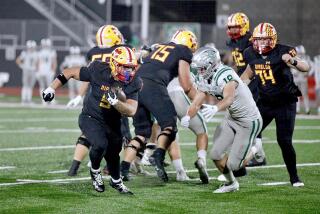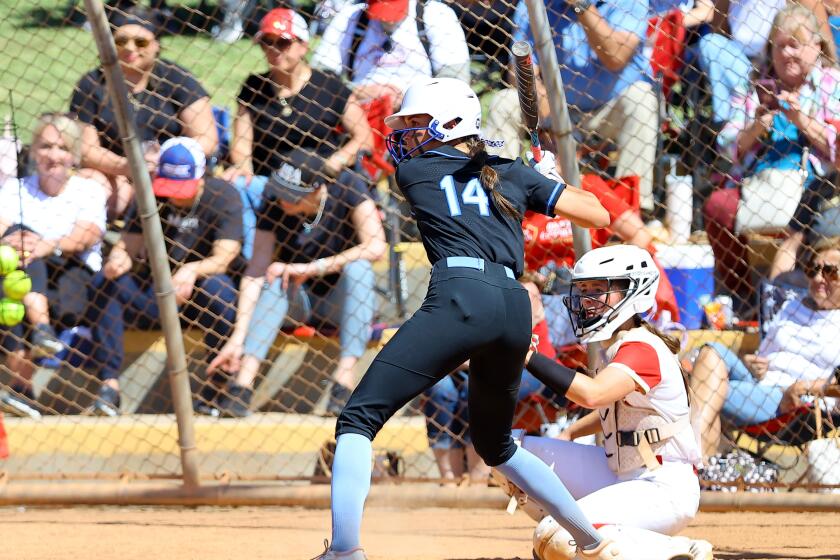CSUN Votes to Step Up to NCCA’s Division I
- Share via
Cal State Northridge physical education instructors and coaches have unanimously recommended that the university step up to NCAA Division I status in athletics.
More than 30 full-time staff members voted to that effect at a retreat in Ventura on Friday. The proposal is expected to be approved by University President James W. Cleary, who last spring requested the athletic department to study the move. Cleary, attending an NCAA meeting in Denver and not expected to return home until late tonight, was unavailable for comment.
“We feel the San Fernando Valley community is ready to support Division I teams,” said Bob Hiegert, Northridge’s athletic director. “We have a 1 1/2-million population base in the Valley and a 30,000 student enrollment. It’s time for us to line up with the Long Beaches and Fullertons, where we belong.”
At the same meeting, the coaches and instructors voted to separate physical education and athletics into two departments. Hiegert said the two recommendations were related.
“I can’t think of a Division I program in the country that has them together,” Hiegert said. “Splitting them would put the athletic department a little more in control of its own destiny.”
Northridge will have to conform to Division I academic and scheduling standards before it can make the move. The school must be in compliance with those guidelines for three years before it can join Division I.
Football would be the only sport not affected by the proposed change. Northridge will remain a member of the Division II Western Football Conference.
For years, Northridge has had one of the nation’s most successful Division II sports programs.
This fall, Northridge soccer and women’s volleyball teams are both top-ranked. The Matadors are also perennially among the nation’s best in men’s and women’s swimming, softball, baseball, men’s and women’s track, women’s tennis, women’s cross-country, golf and gymnastics.
Hiegert said that Northridge simply has outgrown Division II.
Northridge has teams in 10 men’s and eight women’s sports. The Division II minimum is four of each. There is already a proposal to drop the number to three of each.
And while other Division II schools consider dropping sports, Northridge worries about its competition disappearing.
Northridge joins five other Division II schools from the West that have expressed their intention to change classification. Cal State Los Angeles, UC Riverside, Cal State Sacramento, Southern Utah and Grand Canyon of Arizona are the others.
Cal State Bakersfield, Cal State Chico and UC Davis are also reportedly studying possible moves to Division I.
Hiegert said that Northridge might become part of a new Division I conference by aligning itself with some of the other schools in the region that are moving up.
A move to the Pacific Coast Athletic Assn. would be another possibility, Hiegert said, if the planned expansion of Northridge’s football stadium is done in time. The football team would then also have to be Division I.
Cal State L.A., Riverside, Bakersfield and Northridge are now members of the California Collegiate Athletic Assn., along with Cal Poly Pomona, Cal Poly San Luis Obispo, Cal State Dominguez Hills and Chapman.
Sam Winningham, chairman of physical education and athletics, said he will deliver the staff’s proposals to Cleary Tuesday. “The recommendation was that we move as quickly as possible for a move to Division I,” Winningham said. “There are a number of adjustments in scheduling and staff support that we will need to make in preparation.”
Conceivably, Northridge could be ready to make the move by the fall of 1990 if the university decided to recruit next year’s freshmen by Division I academic standards. Division II academic requirements are more lenient than those of Division I.
“The Division II philosophy used to lean very strongly toward academics, but it has shifted away from that,” Hiegert said. “Academics has always been a very important consideration for this university.”
Northridge also considered the way playoff events are funded by the NCAA.
Division II teams that qualify for playoffs have their air fare paid by the NCAA, but other expenses are paid by the universities. In individual sports, the NCAA pays only half the air fare and nothing else.
The setup has been particularly expensive for Northridge, which is strong in swimming, track, tennis, golf and cross-country--all individual sports, according to the NCAA.
More money is available for Division I playoffs, and schools often make money in addition to having their expenses paid.
Men’s basketball is particularly lucrative because of its potential television contracts. Any conference with six members automatically qualifies for entering a team in the NCAA basketball tournament. In most conferences, all schools share a portion of the money earned by the conference representative by qualifying for the playoffs.
Northridge would have to spend more money than it does now to be competitive at the Division I level. Hiegert said that exact figures had not been compiled, but expenditures would increase substantially in some areas if Northridge decides to move up in class.
The extra money, Hiegert said, would have to come from fund raising.
Northridge shouldn’t have much trouble conforming to Division I schedule requirements in most of its sports, with the exceptions of men’s and women’s basketball.
The NCAA requires a basketball team to play all but two games in a year at its level of competition or higher. That means if Northridge were to play 28 basketball games in 1990, 26 of them would have to be against Division I schools.
In the other sports, the NCAA requires a team to play at its level only 50% of the time. If Northridge scheduled 60 baseball games, only 30 would have to be against Division I teams. That number is deceiving, however, according to Hiegert.
“That’s the rule, but when it comes to playoff time, the selection committees would rather see 57 or 58 games against upper-division teams.”
Northridge baseball, softball and swimming teams already schedule many non-conference games against Division I opposition.
“At first we probably won’t be as successful as we have been if we do move up,” Hiegert said. “But I don’t think that should be too much of a concern. It took us a while to get untracked when we first went Division II, and look how successful we’ve been.”
More to Read
Get our high school sports newsletter
Prep Rally is devoted to the SoCal high school sports experience, bringing you scores, stories and a behind-the-scenes look at what makes prep sports so popular.
You may occasionally receive promotional content from the Los Angeles Times.






